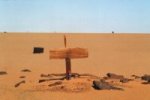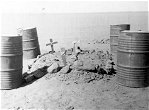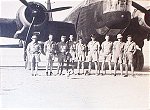

 Site of forced landing
Site of forced landing
SAAF 15th Squadron Det.
4th May 1942
Mystery of the modern beer cans solved, see new info at bottom of page
The following is the testimony of No. 81976 F/SGT. Reginald Arthur Cox - Intelligence N.C.O. 15 Squadron, S.A.A.F. (2nd witness during the Court of Inquiry):
... At about 17.00 hrs. on the 11th May we set off for the two remaining Blenheims and arrived about 07.00 hrs. LT. on the following day.
I knew the sole survivor A/M Juul had been evacuated by air, but I found the eight remaining bodies were dead lying near and under the aircraft. ... I was informed by the
Wellington crew that nothing had been removed from these Blenheim aircraft Z.7610 and T.2252, and I am satisfied that apart from this Wellington no one else had visited the spot.
The aircraft were placed nose to nose and had obviously been pushed into this position. There were ground strips on the ground but not in any formation, and there was no evidence of a signal fire.
There was a parachute spread out nearby on the ground as a signal. I did not find any hand mirrors. I then searched the aircraft and surrounding ground and noted the following points of interest. I found a Navigators Log
and Recconaissance Report in Blenheim Z.7610, which now I produce, but no Navigators Log nor Recce. Report in the other aircraft that had been used. I found five maps excluding the maps in the two
chart boards. These I collected and handed to O.C. 15 S.A.A.F. Squadron, I.F.F. sets have not been destroyed. There were 21 empty water bottles, and one water bottle containing urine. There were
three empty 4 1/2 gallons standard aircraft water containers and two 2 gallon tins also empty. There was a considerable amount of rations lying about unused, but the oil from several tins of sardines and the syrup from the tins of fruit were used up.
All but one of the first aid kits have been opened. The only apparent use made of them was the tube of Gentian Violet. No morphia was used. Some fire extinguishers were broken and the liquid drained. Most of the Oxygen bottles have been used
out of 12. 3 revolvers were found, but others had been taken on the flight. These had been fired and all the ammunition expended from the chambers. One of these revolvers was in Maj. de Wets hand. One pilots compass and both bomb sights
had been broken, but the two bearing compasses and the other pilots compass were intact. It appeared that the aircraft had taken off and landed several times from this spot. I found one Very
pistol and some used cartridges.
At about 10.00 hrs, L.T. on the 12th of May we started to bury the bodies near the aircraft and during this, the Wellington arrived with O.C. 15th S.A.A.F. Squadron, who read the burial service. Before burying the bodies I removed all personal effects...
| Pictures below courtesy Jim Howey, Ontario, Canada, taken by Sergeant (later Flight Lieutenant, DFC) GW Percival, RCAF (162 SQ, piloting 3rd Wellington to arrive to Kufra) |
 |
 |
 |
||
| Z.7610 and T.2252 on the morning of 12th May | The crew of the Wellington that located the site, at Kufra (10-11th May ?) |
An interesting addition: we were not the first to visit the forced landing & grave site since '42. Some distance beyond the pile of petrol cans, I have come upon a little heap of empty cans, some still having their enameled labels on the covered side. They were all english ale cans, I made a photo of the best preserved ones. Already at the spot I suspected, that they were from a post war date, but did not put much thought to it.
After some search on the web it emerged that the cans on the right are Tennent's Scottish Lager, the 'First Scottish Series',
on sale in 1959-1960. The one on the left is Watneys Red Barrel - Watney Pale Ale. (www.beercans.org)
Possibly the same oil exploration team who found Z.7513 in February 1959 visited this site as well ?
It was known, that the bodies at the landing site of Z.7513 were exhumed and re-buried in the Allied War Cemetery at Tobruk. Francois de Wet recently established, that the 8 bodies at the first landing site were also exhumed later in 1964, following the re-discoverey of the single Blenheim in 1963 by a RAF pilot (after it was found by the oil exploration people in 1959). The RAF put up a rather poor show, as only one of the 8 next of kin were notified, the de Wet family never received any news.
The Tennent's beer cans almost certainly came from this time.